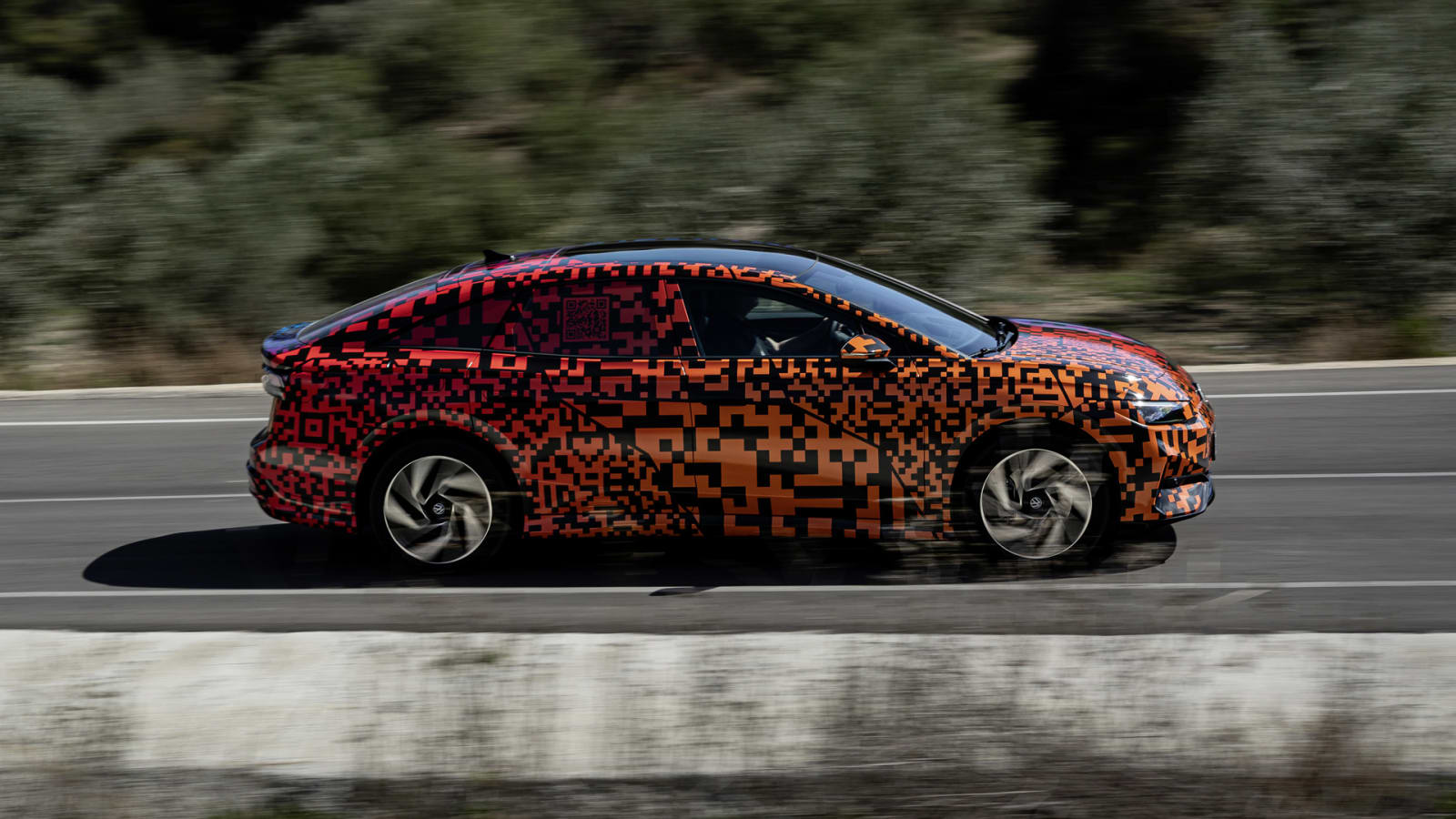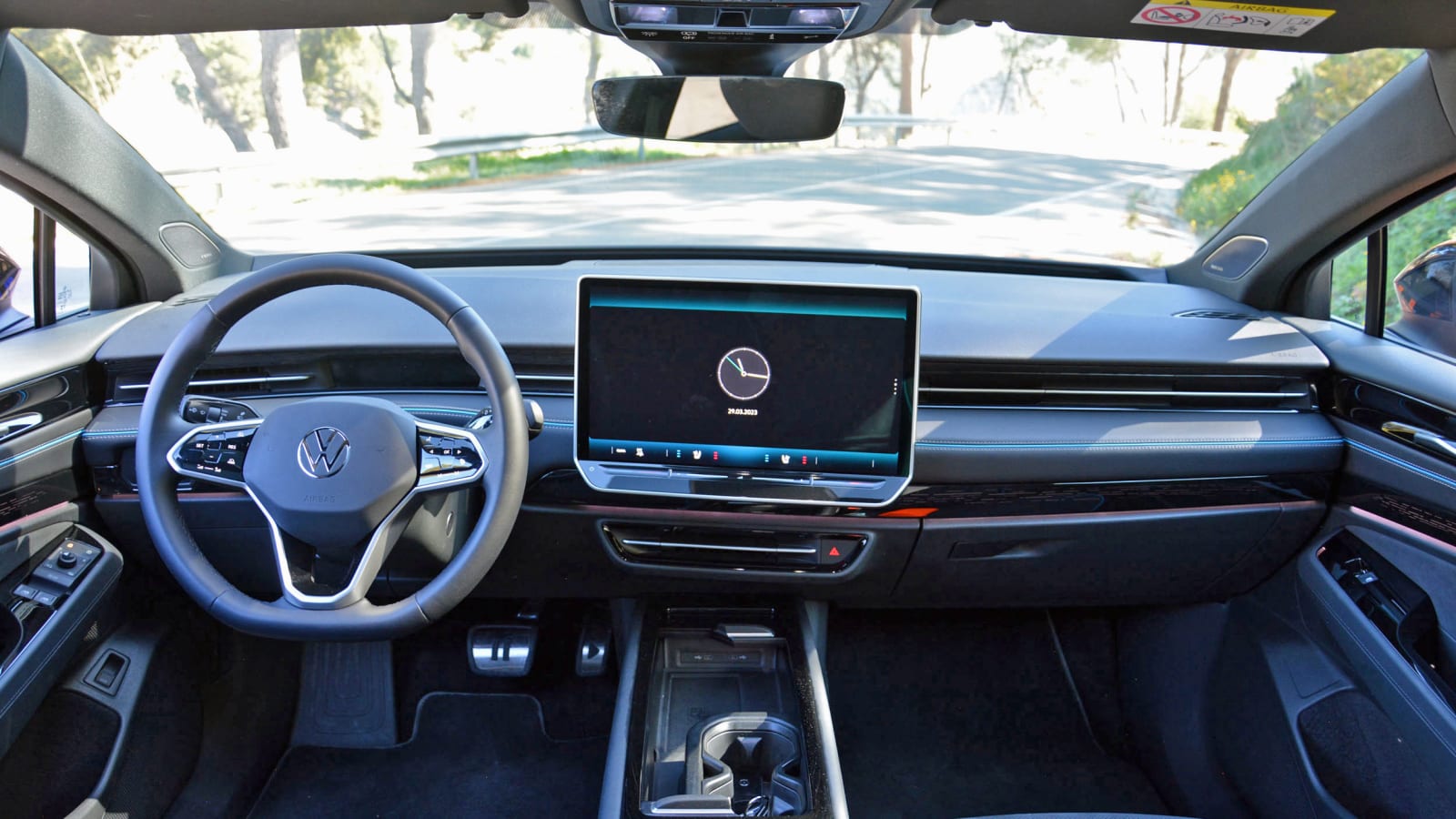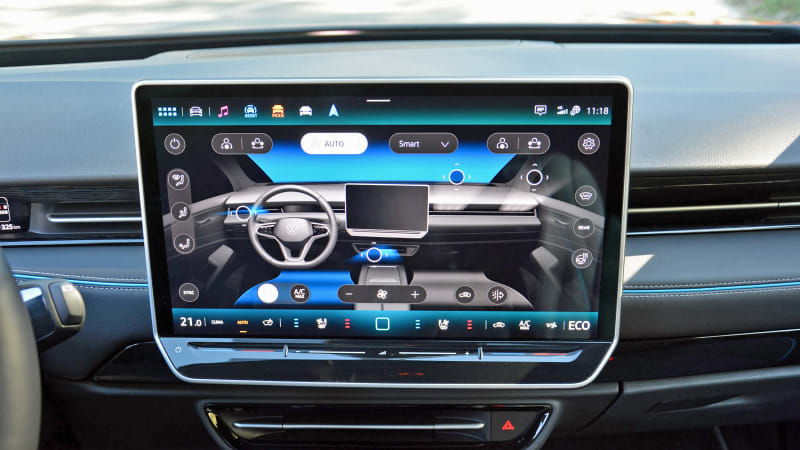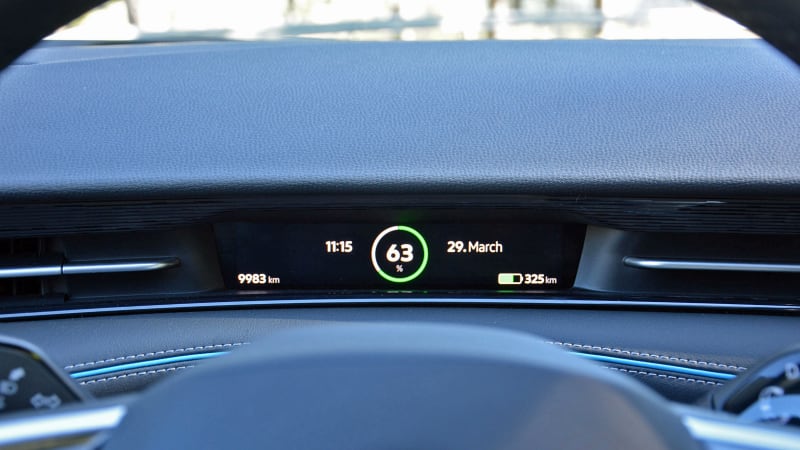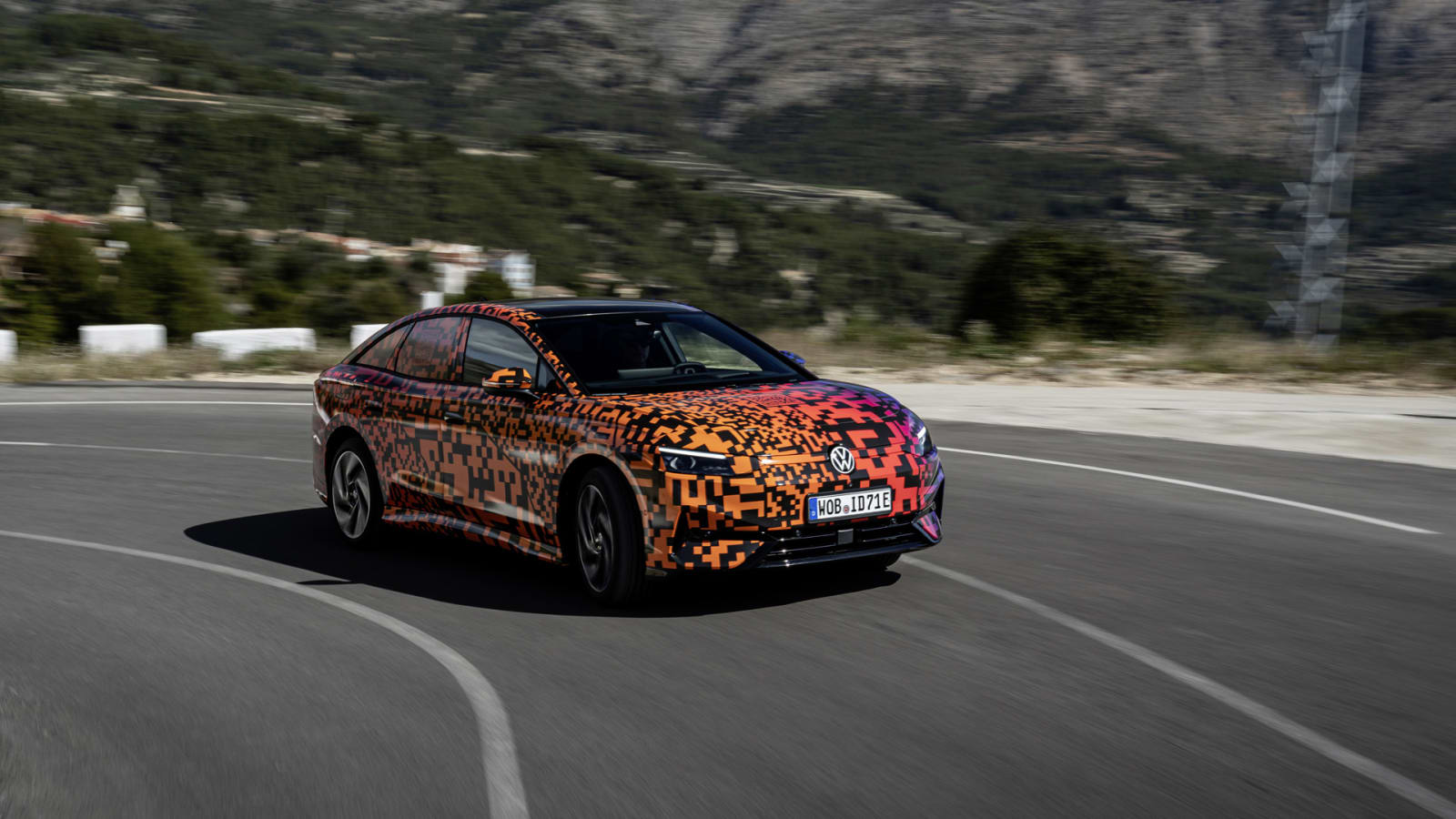ALICANTE, Spain — Volkswagen isn’t out of ideas when it comes to electrifying its lineup. Globally, its family of ID-branded EVs includes the Golf-sized ID.3 hatchback, the ID.4 crossover, and the long-awaited ID. Buzz. One of the empty slots is shaped like a sedan, and the company will fill it when it turns the ID.Aero concept unveiled in 2022 into a flagship sedan called ID.7. The model won’t make its debut until later in 2023, but I had the opportunity to take a prototype for a quick spin.
The word “flagship” is nebulous; it means different things to different companies. You’re on the wrong track if you’re thinking about a follow-up to the Phaeton, the underrated, Bentley-related luxo-barge developed to take on the S-Class and launched for 2004. The ID.7 will be positioned closer to the Arteon, meaning it will be big and expensive for a Volkswagen instead of big and expensive, period. It’s not being developed to compete in the same arena as, say, the Mercedes-Benz EQS or the BMW i7.
I can’t tell you much about the ID.7’s exterior design because I’m sworn to secrecy until the sedan’s official unveiling on April 17. What I can say is that, like the concept, the production model was designed to be as aerodynamic as possible. Volkswagen pegs the sedan’s drag coefficient at 0.23, which lands in the same bracket as electric sedans like the BMW i4 (0.24) and the Porsche Taycan (0.22). It stretches 195.3 inches long, 73.3 inches wide, and 60.6 inches tall, which is bigger than the American-market Passat Volkswagen axed in 2022 that was a huge car itself, measuring 191.9 inches long, 72.2 inches wide, and 58.5 inches tall. The ID.7 rides on a 116.8-inch wheelbase, while the Passat’s wheelbase checked in at 110.4 inches.
The relatively long wheelbase hints at what’s beneath the sheetmetal. Volkswagen built the ID.7 on the modular MEB platform that underpins its existing ID models. It’s an architecture designed specifically for EVs, so the company is able to experiment with different packaging solutions and proportions. This partly explains why the ID.7 has a wheelbase that’s so much longer than the Passat’s, and why it’s 2 inches taller. An electric motor is more compact than a turbo-four, but the battery hogs space in the underbody.
Using the MEB platform makes the ID.7 the first rear-wheel-drive Volkswagen sedan in many decades, but Volkswagen didn’t merely reskin the ID.4 into a fastback. The drivetrain’s core is an updated electric motor that benefits from a number of updates, including water- and oil-based cooling systems. Yes, this is an EV that you can perform an oil change on … although Volkswagen tells me the oil (which is closer to transmission oil than to engine oil) and the filter shouldn’t need to be changed because they’re designed to last the life of the car. Don’t open up an EV-only Jiffy Lube franchise just yet.
The motor’s output checks in at 282 horsepower and 402 pound-feet of torque, so it’s the most powerful unit in Volkswagen’s arsenal, and it spins the rear wheels via a single-speed automatic transmission. Will this motor find its way to other ID-badged EVs? Will a dual-motor all-wheel-drive variant of the ID.7 join the range sooner or later? My crystal ball answers “yes” to both questions, but this is pure speculation.
Globally, the ID.7 will launch with two available lithium-ion battery packs: the base Pro trim will ship with a 77-kilowatt-hour unit while the Pro S will receive an 86-kilowatt-hour unit. As is often the case, driving range depends on who you ask and how you drive. In Europe, Volkswagen expects that the smaller pack will deliver up to 382 miles of range while the bigger pack should power the ID.7 for up to 435 miles. However, these figures are estimates obtained using Europe’s WLTP testing cycle, which leans towards the optimistic side of the scale. The EPA-estimated numbers should be lower for both battery packs.
The ID.7’s flagship aspirations — and the benefits of stretching the wheelbase — are clear in the driver’s seat. There’s more interior space than the fastback-like silhouette suggests, and folks sitting in both rows benefit from it. I’m 5-foot-11 so I’m fairly easy to sit behind, even in a European-market hatchback. However, in the ID.7 I was able to sit behind a colleague who stands 6-foot-5 with plenty of room to spare; that’s fairly impressive. There’s plenty of headroom in both rows, and Volkswagen quotes approximately 18.7 cubic feet of trunk space, with more available if you fold down the rear seats. That’s also better than the old Passat.
Once you’ve made yourself comfortable, look around and the ID.7 strikes you as a combination of old and new. It feels like the existing members of the ID family in many ways, the pedals are labeled “pause” and “play” and rear window switches still haven’t made their way to the driver’s door panel, but many of the features that need improvements have been improved. The volume knob … still hasn’t landed. But, the touch-sensitive slider positioned below the touchscreen is now backlit, so it’s easier to use at night.
Speaking of the touchscreen, the ID.7 receives a 15-inch unit (up from 12 inches in the ID.4) that displays a new version of Volkswagen’s infotainment system. Some of the changes made to the software reflect a reality that’s becoming increasingly clear across the entire automotive spectrum: Using what’s pretty much a giant smartphone to control your car is relatively dangerous. Volkswagen doesn’t want you hitting a deer or worse while you’re trying to turn down the heater, so it added tile-like modules to the home screen so that commonly-used features such as the climate control system’s settings are displayed front and center at all times. These co-exist with other menus, like the navigation system and entertainment options. You can adjust, say, the heater fan speed without leaving the navigation screen. Saving two or three taps of a touchscreen might sound totally trivial, but it makes a massive difference while driving.
Volkswagen’s commitment to keeping the driver focused extends beyond the touchscreen. In the driver’s seat, you face a digital instrument cluster that’s embedded into the dashboard and much smaller than the unit fitted to the ID.4, while an augmented-reality head-up display shows additional information, such as navigation directions. The ID.7 also features what the company calls “smart air vents” — they’re electronically controlled, and adjustments need to be made via the touchscreen (above left). This setup will take a certain amount of time to get used to, but at least it’s reasonably intuitive. Big, vague swipes of the screen allow you to move individual vents; alternatively, you can use voice commands to direct the air where you want it to go. “Hello, Volkswagen, my hands are cold” summons warm air on your hands. So, it works, but we’d love to meet the person who finds all that quicker and more convenient than leaning forward a bit and moving a toggle half an inch.
To further drive home the “flagship” point, Volkswagen makes upmarket features available in the ID.7. Globally, buyers will be able to configure the ID.7 with massaging 14-way power front seats, 30-color ambient lighting, and a 14-speaker Harman Kardon sound system. It’s too early to tell which features will be offered in America, however.
My time behind the wheel of the ID.7 was spent in a pre-production, fully-camouflaged prototype on the squiggly roads that run through the mountains north of Alicante, Spain. It takes a couple of turns to realize that this big sedan doesn’t drive like a rear-wheel-drive car. This is partially due to the heavy battery pack mounted under the cabin, where it lowers the center of gravity and places it in the middle of the car. The result is handling that’s more balanced and less playful than you’d expect from a rear-driven, rear-engined sedan. It’s quiet and comfortable above all, and Volkswagen fitted a five-link rear axle that helps deliver the kind of smooth, predictable ride you want on a long drive.
I couldn’t coax anyone at Volkswagen into telling me the ID.7’s weight, but I imagine it’s not light (EVs never are). And yet, it feels reasonably quick — 282 horsepower isn’t huge, but 402 pound-feet is nearly on par with a V8-powered Ford F-150, and the motor’s full torque output is available off the line. This is a boon in the mountains, where you’re constantly slowing down for a turn, accelerating, crawling behind a group of cyclists, and passing when the opportunity arises. I’d guess it also makes the ID.7 right at home on the freeway, though beyond a short above-the-limit stint, I wasn’t able to test higher speeds. It has to: Freeway-worthiness is an important trait in the constitution of a big German sedan’s character.
Volkswagen programmed four driving modes called Eco, Comfort, Sport, and Individual, which are accessible conveniently via an icon at the top of the touchscreen. Comfort is the default profile, and the one that best suits the ID.7’s character. Sport sprinkles a dash of performance over the overall experience but stops short of turning the ID.7 into a GLI. The throttle response becomes sharper, but the steering remains light and the suspension system doesn’t feel markedly different. It’s never overly firm, it keeps excessive body roll in check, but it was clearly tuned with comfort in mind. Eco neuters the car to save driving range, and Individual lets the driver dial in different settings to create a custom profile.
Once you’ve chosen (or created) a profile, you’ve got an additional choice to make: D or B. Folks driving an ID.4 will be familiar with these options. Leave the gear selector in D and the ID.7 coasts when you lift your foot off the accelerator. The drivetrain recuperates energy, but it largely happens behind the scenes and you need to step on the brake pedal (or, in Volkswagen-speak, the pause button) to come to a full stop. Flicking the gear selector into B brings a noticeable, one-pedal-driving-friendly amount of regen, especially when Sport mode is engaged. There’s no right or wrong answer: It’s a matter of preference. Dialing in additional regen levels wouldn’t hurt, as in the various Hyundai/Kia models that will also come to a stop by themselves, but there’s something to be said for keeping it simple.
I’ll need to wait until I spend time in a production model to decide if the ID.7 deserves the flagship label, but my early impressions are positive. It doesn’t try to be something it’s not: It offers big-car comfort and technology without masquerading as an alternative to the Audi A8 or trying to make the driver believe it can outrun a BMW M3 on Laguna Seca. How it will be welcomed in the United States, where the big sedan market looks like the National Museum of Natural History’s dinosaur room, depends largely on whether it’s priced like a flagship or like a Volkswagen flagship.
Built in Emden, Germany, for the American and European markets, and in China for China, the Volkswagen ID.7 will make its global debut on April 17. Pricing and full specifications will be released in the weeks leading up to its on-sale date. Sales in the United States are scheduled to start in 2024.


